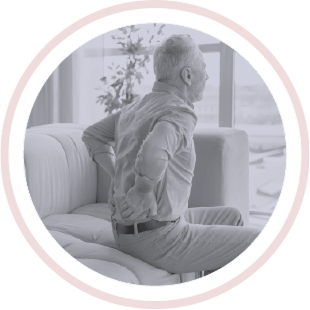Degenerative conditions can be defined as illnesses that cause a progressive breakdown of cells, tissues, or organs over time, leading to a decline in function. These conditions can affect various parts of the body, but when discussed in the context of workers’ comp, “degenerative conditions” often refers to such conditions of the musculoskeletal variety.
While different degenerative conditions may have varying causes, the prevalence of these conditions increases with age and the wear and tear of the human body, sometimes tied to certain repetitive motions over a significant period of time.
Delineating between a work-related injury and a degenerative comorbid condition can be difficult, but recent data make it clear that the presence of degenerative conditions within claims can significantly impact claims outcomes and costs.
With this in mind, what do workers’ comp stakeholders need to know about degenerative conditions?
The Workers’ Compensation Research Institute (WCRI) found that degenerative comorbid conditions are present in 18.7% of workers’ comp claims. This includes:1
Osteoarthritis, found in 9.7% of claims
Spondylosis (with or without nerve involvement), found in 6.2% of claims
Degenerative disc disease, found in 5.6% of claims
Spinal stenosis, found in 4.2% of claims
While this is not an exhaustive list of common degenerative conditions, the WCRI did find that average costs and temporary disability duration for claims with these degenerative comorbid conditions were much higher than claims without them.
Additionally, among claims involving back and shoulder injuries, those with a degenerative comorbid condition are 58% more likely to become a high-cost claim – with medical payments in excess of $65,000 within 36 months of injury.2
While degenerative conditions are caused by multiple factors, the primary cause is natural deterioration due to age, which is reflected in their prevalence among older populations. This also has implications for workers’ comp, as the workforce continues to grow older.
20% of adults age 65+ are participating in the workforce3
By 2030, 9.5% of the workforce is projected to be older than 654
The percent of people aged 75+ in the workforce is expected to hit 11.7% by 20304
The labor force for those aged 75+ is expected to grow by 96.5% over the next decade4
1 in 3 people over 65 have OA
of people with OA are 45+
of people with OA are 65+
of adults aged 50-64 have osteoporosis
of adults 50+ have osteoporosis
of adults aged 65+ have osteoporosis of the femur neck or lumbar spine
of adults aged 65-69 have osteoporosis
of adults 65-69 have disc degeneration
of all U.S. adults have some amount of disc degeneration by age 65
of adults aged 60+ have sarcopenia
of adults age 80+ have sarcopenia
of adults 65-69 had spinal stenosis
of older adults in the U.S. develop spinal stenosis
of adults aged 40+ have cervical spondylosis
of adults aged 60+ have cervical spondylosis
While the WCRI has published data on select degenerative conditions within workers’ comp, there are a larger variety of these conditions that may not be noted in claims, but which are common within the larger U.S. population and which could impact severity of injury, recovery, and claim duration and cost.
Osteoarthritis (OA) is the most common type of arthritis and causes joint pain, stiffness, and swelling, usually in the hands, hips, back, or knees. OA can develop when the protective cartilage that cushions the ends of the bones wears down over time, causing bone to rub on bone. Over time, OA can lead to changes in bone, cartilage, and other joint tissues, resulting in disability or making it hard for someone to do work or daily tasks.13-14
While there is no cure for OA, staying active, keeping a healthy weight, and protecting the joints can minimize pain and discomfort, and slow the progression of the disease. Furthermore, physical therapy can help strengthen muscles around affected joints, while crutches, canes, and other aids can help to avoid stressing joints. For more severe cases, surgery may be considered.13-14
As for pain relief, commonly prescribed medications for OA include:13, 15
Clinical Expertise from Tate Rice, PT, DPT, MBA, Director of Product Management

Several different parts of the body support the joints, and it is important to understand when physical therapy can and cannot help manage degenerative conditions.
These joint-supporting systems can be divided into contractile structures (those able to contract and relax) and non-contractile structures (those unable to contract and relax). Depending on patient-specific factors, damage to these different types of structures can impact the efficacy of physical therapy.
Contractile elements are the dynamic restraints of the joint and can be rehabilitated in physical therapy. These structures can be targeted and strengthened in order to minimize the effects of degenerative conditions.
These include:
Non-contractile structures act as passive restraints of the joint and cannot be directly rehabilitated in physical therapy. This includes:
Osteoporosis is a bone disease that develops when bone mineral density and bone mass decreases, leading to a decline in bone strength that can increase the risk of fractures. Sometimes osteoporosis does not have symptoms and may go unnoticed until a fracture occurs. However, once bones have been weakened by osteoporosis, signs and symptoms can include back pain, a loss of height over time, and a stooped posture.16-17

Osteoporosis is the major cause of fractures in postmenopausal women and in older men, and osteoporosis-related breaks most commonly occur in the hip, wrist or spine. Bones affected by osteoporosis may become so fragile that fractures occur spontaneously or as the result of minor falls and normal stresses such as bending, lifting, or even coughing.16-17
The impacts of osteoporosis can be lessened by staying physically active and participating in weight-bearing exercises such as walking, as well as eating a nutritious diet rich in calcium and vitamin D to help maintain good bone health. Additionally, quitting smoking and drinking in moderation can help. Surgery may be considered for more severe cases.16
Medications commonly used for the treatment of osteoporosis can include:18
Also known as intervertebral disc degeneration, degenerative disc disease (DDD) is arthritis of the spine, where cartilage has worn out, allowing the soft discs in the vertebrae to partially dry out and shrink, narrowing the space between the vertebrae and making the spine less stable. This decreases flexibility and can cause pain, weakness, or numbness. It is known to cause sharp pain that can worsen with activity, as well as soreness and sometimes tingling. However sometimes DDD can be undetected if it hasn’t yet caused pain. While DDD primarily affects the neck and lower back, it can extend to arms, hands, feet, and legs.19-22

While DDD is primarily caused by age, tears in the outer portion of the disc due to daily activities, sports, or injury can contribute to DDD.22
Surgery may be required for more severe cases of DDD, but often pain can be managed by a combination of hot/cold therapy, physical therapy, and certain medications for pain and inflammation.22
Commonly used pain medications for DDD include:19, 22
Sarcopenia is an age-related loss of skeletal muscle mass, strength, and function that can result in decreased mobility and an increased risk of adverse outcomes including falls, fractures, and premature mortality.10, 23-24
While sarcopenia commonly occurs with advancing age, other potential risk factors include:25

Physical activity (particularly resistance training), increasing protein intake, and minimizing stress on the body can help manage symptoms of sarcopenia.10
At this time, there are no FDA-approved drugs for sarcopenia, though there is clinical research surrounding medications that could impact muscle metabolism.
Spinal stenosis is a condition where the spinal canal narrows, putting pressure on the spinal cord and nerves. While there can sometimes be no symptoms, the inflammation caused by spinal stenosis can result in pain, numbness, and weakness to the back, neck, and limbs.26-27
Spinal stenosis is primarily tied to age-related wear of the spine, but it can impact younger populations due to injury and other factors. This can include:26-27

Spinal stenosis – including its resulting inflammation – can be treated with physical therapy for increasing mobility, strength, and endurance, all which help to stabilize the spine. Additionally, the use of a brace, massage therapy, or acupuncture can help with pain. For more severe cases, surgery may be considered.28-29
Medications commonly used to treat the pain associated with spinal stenosis include:28-29
Spondylosis is the age-related wear and tear of spinal discs, impacting the neck, mid-back, and lower-back. Symptoms can include pain, stiffness, compression of neural structures, tingling, numbness and weakness in arms, hands, legs, or feet, a loss of bladder or bowel control, a lack of coordination, and difficulty walking. 30-31

Spondylosis is a natural process of aging and is present in the majority of people after the fifth decade of life. However, other possible causes can include:30
For less severe cases, spondylosis can be treated with a combination of physical therapy, hot/cold therapy, the use of neck braces or a cervical collar to let the muscles rest, and alternative therapies like chiropractic, massage, and acupuncture. Surgery may be considered for more serious cases.31-32
The following medications may be used for the treatment of pain:31-32
Degenerative conditions are in many cases an inevitable consequence of aging, but when properly managed, individuals can still live productive lives, including in the workplace. Having visibility into a degenerative comorbid condition can help with managing the health of the injured worker, their recovery, and the claim in a number of ways:
The subject of degenerative conditions can quickly become complex when it comes to determining if the condition is pre-existing and aggravated by the workplace injury or caused by a workplace injury.
Making this determination can be difficult, but it is important to make this distinction because it impacts compensability, and by extension it can impact an injured worker’s understanding of their care. When faced with ambiguous determinations, an age of injury diagnostic analysis may help to identify if a degenerative condition pre-exists the injury or is a result of an injury.
